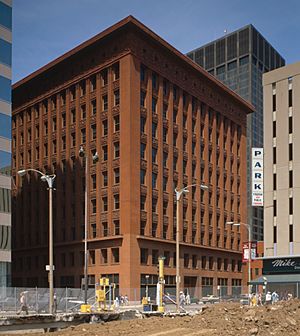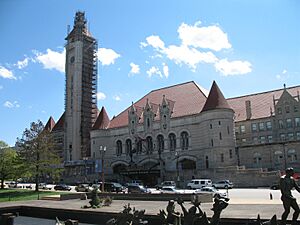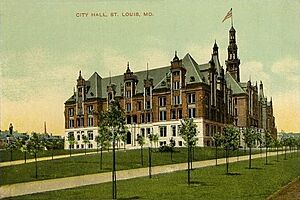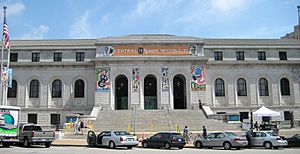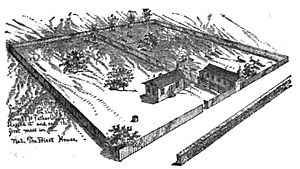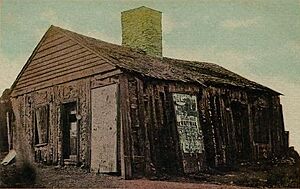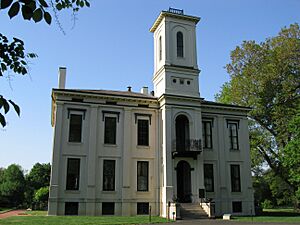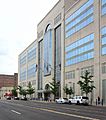Architecture of St. Louis facts for kids
The architecture of St. Louis shows many different kinds of buildings. These include homes, businesses, and big monuments. St. Louis, Missouri, is famous for the Gateway Arch. This is the tallest monument ever built in the United States. Buildings in the area show influences from French, German, and early American styles. You can also see European, French Second Empire, Victorian, and modern designs.
Contents
Tall Buildings and Skyscrapers
St. Louis had many of the first tall buildings, called skyscrapers, in the late 1800s. Two important early skyscrapers were designed by Louis Sullivan. His Wainwright Building from 1891 is a great example. It has a strong base and a tall, decorated middle section.
Other important downtown skyscrapers from that time include the Railway Exchange Building (1913). The Fagin Building was also built then. Some old factory buildings have been turned into fun places. For example, the International Shoe factory became the City Museum. Sadly, some important buildings like the St. Louis Century Building were torn down.
In Midtown St. Louis, many theaters and tall office buildings were built. This was between the Central West End and downtown. Examples include the Gothic Revival Continental-Life Building (1929). The Neo-Renaissance Fox Theatre (1929) is another. The Fox was a huge movie theater that could hold over 5,000 people. It was the second-largest cinema in the U.S. Since 1982, it has been a place for live shows. Another Midtown building from the 1920s is the Neo-classical Powell Symphony Hall (1925). It used to be a movie and show theater. Now, it is home to the St. Louis Symphony.
Some modern tall buildings were built downtown in the 1970s and 1980s. These include the One US Bank Plaza (1976) and the AT&T Center (1986). One Metropolitan Square (1989) is the tallest building in St. Louis. One US Bank Plaza shows its steel structure on the outside.
In the 1990s, St. Louis built the largest U.S. courthouse by size. This is the Thomas F. Eagleton United States Courthouse (finished in 2000). It houses federal courts. The newest tall buildings are homes. These include the Park East Tower and the Roberts Tower. One Hundred Above the Park is the tallest building outside of downtown.
Famous Places and Monuments
Many old churches still stand from before the Civil War. Most look like the homes built at that time. One of the oldest is the Basilica of St. Louis, King of France. People call it the Old Cathedral. It was built between 1831 and 1834. Other old religious buildings include SS. Cyril and Methodius Church (1857). Christ Church Cathedral (1867) is another.
Few city buildings were built in the early 1800s. The first St. Louis courthouse was built in 1826. It had a stone front. This courthouse was later changed and made bigger in the 1850s. The Old St. Louis County Courthouse was finished in 1864. It was special for its early cast iron dome. It was the tallest building in Missouri until 1894.
Many old buildings along the river were torn down. This happened when the Gateway Arch was built. But some old buildings remain. Laclede's Landing is a district with cobblestone streets and brick warehouses. It is now popular for restaurants. Parts of the Anheuser-Busch Brewery also date back to the 1860s.
St. Louis built many more churches in the late 1800s and early 1900s. The biggest and most decorated is the Cathedral Basilica of St. Louis. It was built from 1907 to 1914. It has one of the world's largest collections of mosaics. St. Stanislaus Kostka is another important church. It shows the Polish Cathedral style. Other major designs include St. Alphonsus Liguori (1867). People call it The Rock Church. The Second Presbyterian Church of St. Louis (1900) is also notable.
Around the 1904 World's Fair, many churches moved to the Central West End. This area is near Forest Park. The Holy Corners Historic District has many historic religious buildings. One example is the First Church of Christ, Scientist (1904).
By 1900, St. Louis was the fourth largest city in the U.S. In 1904, the city hosted a world's fair at Forest Park. Brookings Hall at Washington University in St. Louis was its main office. The fair left behind cultural places. These include the Saint Louis Art Museum, designed by Cass Gilbert. The Flight Cage at the St. Louis Zoo is another. The Missouri History Museum was built with money from the fair. The fair also improved Forest Park and left Theodore Link's 1894 St. Louis Union Station.
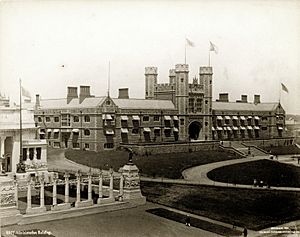
Louis Sullivan also designed the Wainwright Tomb in Bellefontaine Cemetery. It is surrounded by other tombs of famous St. Louis families. These tombs have interesting artwork from the late 1800s.
After the Civil War, St. Louis quickly grew its school and hospital systems. One of the oldest hospital buildings is the St. Louis Insane Asylum. It is now the Metropolitan St. Louis Psychiatric Center. It is made of brick and has a dome like the Old Courthouse.
As St. Louis grew, the city hall moved west in 1904. Construction started in 1892. St. Louis City Hall is still used today. It was designed by Harvey Ellis. It looks like the famous Hôtel de Ville, Paris, France.
Other important city buildings from the late 1800s and early 1900s include the U.S. Customhouse and Post Office (1873). The grand St. Louis Public Library by Cass Gilbert (1912) is another. Both have been recently fixed up. In 1923, the city decided to improve the Civic Plaza. This led to major city buildings like the Soldiers' Memorial and the Civil Courts Building.
In the 1940s and 1950s, a modern style of St. Louis architecture appeared. Harris Armstrong was a local architect. Daring modern landmarks were built. These include Gyo Obata's Planetarium. The dome-shaped Climatron and the main building at Lambert-St. Louis International Airport are also examples. The Poplar Street Bridge was built in 1967. It is 647 feet long and carries several major highways. The Gateway Arch is the most famous modern building. It was designed by Eero Saarinen. This stainless-steel arch is the main part of the Jefferson National Expansion Memorial by the river.
Homes and Houses
The first homes in St. Louis were built in the French Colonial style. Even when Spain took over the land in 1764, St. Louis remained a French settlement. So, French architecture was common until the late 1700s. Three main types of homes showed French influence. The most common was the French Colonial log home. Its walls were made of upright wood beams. Roofs were made of thatch or wood shingles. Most St. Louis homes in the late 1700s were like this.
The second type was a frame house. These were built with a wood frame on a stone base. Roofing was similar to the log homes.
The third style was a rock house. Only the richest people could afford homes made entirely of rock walls. This was because they were hard to build. The oldest house in St. Louis, Pierre Laclede's home, was made of rock. Rock houses often had steep roofs.
Country Homes
The first American homes in St. Louis were simple log cabins. Homes in the farmlands were plain. They usually had one or two rooms. Some were larger, with a hallway connecting two rooms. Many of these country homes were torn down as the city grew. But some were more developed and became part of the city streets.
More developed country homes often looked like the Federal Style. They had simple, balanced fronts. They also had windows with shutters and little decoration. Few of these homes still exist. The Lewis Bissell House (1820) is one example. It is now a restaurant.
Other country styles included Greek Revival, Italianate, and Gothic Revival. The Chatillon-DeMenil House (1849) was first Federal Style. It was later rebuilt in Greek Revival. Tower Grove House (1849) was a notable Italianate home. It was built in Henry Shaw's garden. This garden later became the Missouri Botanical Garden.
German immigrants also influenced homes. They brought the fachwerk building method. This uses a timber frame filled with other materials. These homes often looked like regular frame houses. Few were built after 1840 because they were difficult to make. Most are in the Soulard or Carondelet neighborhoods. Germans also built stone houses. Some examples are still in Carondelet.
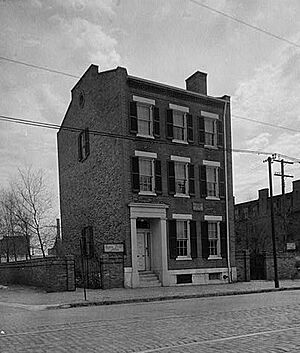
City Homes
Most city homes were townhouses. They were similar to country homes of the same time. City homes in St. Louis were in Greek Revival, Federal, and Italianate styles. Many homes mixed these styles. The Joseph Campbell House (1851) is one example. It is now a museum. Another of Henry Shaw's homes, the Henry Shaw City House (1851), mixed Federal and Italianate styles. It was later moved to the Missouri Botanical Garden. The Eugene Field House (1829) is one of the oldest townhouses still standing.
Some simpler city homes were also built. These include shotgun houses, which are narrow with a side entry. Flounder houses are also narrow with a side entry. They have a sloped roof from one side wall to another. In working-class areas, where space was tight, townhouses faced the street. Flounder houses often faced an alley on the same property.
St. Louis built many more homes in the late 1800s and early 1900s. Like other cities, St. Louis has many Victorian homes. This includes Second Empire-style homes in Lafayette Square. In the late 1800s, St. Louis became known for its private places. These were neighborhoods with large mansions. They shared things like streets and gardens. Many of these private areas are still well-kept today.
Important styles in these private places include Chateauesque and Beaux-Arts. You can also find Tudor Revival and Jacobethan styles. New styles also appeared outside private areas. Homes further west show the Arts and Crafts Movement and Prairie style influences.
After World War I, many new homes looked like the Colonial Revival style. They had traditional brick, dormers, and balanced designs. A good example is at 47 Portland Place. Many working-class homes in the 1920s and 1930s were bungalows. These are found all over south St. Louis. At the same time, more apartment buildings were built west of downtown.
Some of the most fancy homes from the 1920s and 1930s were apartments and hotels. The Central West End neighborhood has examples. These include the Chase Park Plaza Hotel (1931) in the Art Deco style. Hampden Hall (1925) is in the Neo-Renaissance style.
Few city buildings existed during the French period. Government business was often done at the governor's home. The first church was built around 1770. It was later replaced.
After the United States bought Louisiana (including St. Louis) in 1804, more Americans moved to the village. They built frame homes. After 1810, they started building with brick. Some old photos show these early homes. But no buildings from the French colonial time are known to still exist in St. Louis.
City Changes and Saving Old Buildings
After the 1950s, more people moved to the suburbs. This made the city less crowded. In 1957, nearby Clayton, Missouri removed its height limits for buildings. Clayton became another place for businesses to build in the 1960s and 1970s. Different city projects cleared some low-income areas. They built new housing projects there.
One of these projects was Cochran Gardens, built in 1953. It was first for white residents. In 1956, it became open to everyone. Soon after, the famous Pruitt–Igoe project replaced a neighborhood. It had 33 tall buildings. By the mid-1960s, these projects had problems. Pruitt–Igoe was torn down in the 1970s. Cochran Gardens also had problems and was torn down in 2008.
In recent years, many groups have worked to save historic buildings in St. Louis. The Landmarks Association of St. Louis is one such group. It has been working since the 1960s. The Cultural Resource Office is a city agency. It keeps a list of St. Louis city landmarks. Another group, the National Building Arts Center, saves important parts of buildings before they are torn down.
Architects of St. Louis
- Harris Armstrong
- George I. Barnett
- Thomas P. Barnett
- William Bernoudy
- Charles B. Clarke
- Eames and Young
- William B. Ittner
- George Kessler, city planner
- Theodore Link
- John Mauran
- Gyo Obata of HOK
See Also
- Landmarks of St. Louis, Missouri
- List of tallest buildings in St. Louis
- Neighborhoods of St. Louis
Images for kids
-
Bryan Hall in Washington University in St. Louis
-
St. Louis Union Station Grand Hall
-
Gateway Arch from the mall
-
City House in Grand Center, Second Empire style townhouse
-
Old Grand Avenue Water Tower, 1871
-
Danforth University Center in Washington University in St. Louis


